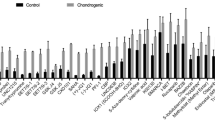Abstract
Histone deacetylase inhibitors (HDACi) are a class of compounds that suppress the function of histone deacetylases (HDACs). This study was performed to examine the effects of Trichostatin A (TSA), a typical HDACi, on chondrogenesis of human bone marrow mesenchymal stem cells (hBMMSCs) and related molecular pathways. After evaluating the concentration for cytotoxicity and HDAC activity, hBMMSCs underwent chondrogenic differentiation in pellet culture with or without TSA for 21 days. The weight of TSA-treated pellets was 25% lower than that of untreated pellets. DNA level was not significantly different, but glycosaminoglycan content per DNA level was lower in TSA-treated pellets than that of untreated pellets. Gene expression of the chondrogenic markers (SOX9, Aggrecan, and Col2A1) decreased by by 12.9-fold, 8.9-fold, and 7.6-fold respectively in TSA-treated pellets compared with that in TSA-untreated pellets. TSA-treated pellets had lower cell density and lower proteoglycan staining content compared with those of TSA-untreated pellets. A microarray analysis from TSA-treated pellets showed that 1,467 chondrogenic-related genes were downregulated and 1,524 were upregulated by more than 2-fold compared with TSA-untreated pellets. Col10A1, TGF-β3, and SOX9 decreased significantly by 10-fold, 2.1-fold, and 3.2-fold respectively in TSA-treated pellets compared with those in untreated pellets, whereas expression of BMP4 and FGFR3 increased significantly by 2.1-fold and 5.4-fold respectively. It is concluded that TSA inhibits chondrogenesis and does not seem to be useful for cartilage tissue engineering of hBMMSCs.




Similar content being viewed by others
References
Tuan RS, Boland G, Tuli R. Adult mesenchymal stem cells and cell-based tissue engineering. Arthritis Res Ther. 2003;5:32–45.
Herzog EL, Chai L, Krause DS. Plasticity of marrow-derived stem cells. Blood. 2003;102:3483–93.
Wang JP, Wen MH, Chen YT, Lee HH, Chiang ER, Lee YT, et al. Trichostatin A inhibits TGF-beta1 induced in vitro chondrogenesis of hMSCs through Sp1 suppression. Differentiation. 2011;81:119–26.
Sengupta N, Seto E. Regulation of histone deacetylase activities. J Cell Biochem. 2004;93:57–67.
Aoyama T, Okamoto T, Kohno Y, Fukiage K, Otsuka S, Furu M, et al. Cell-specific epigenetic regulation of ChM-I gene expression: crosstalk between DNA methylation and histone acetylation. Biochem Biophys Res Commun. 2008;365:124–30.
Karantzali E, Schulz H, Hummel O, Hubner N, Hatzopoulos A, Kretsovali A. Histone deacetylase inhibition accelerates the early events of stem cell differentiation: transcriptomic and epigenetic analysis. Genome Biol. 2008;9:R65.
Chen TH, Chen WM, Hsu KH, Kuo CD, Hung SC. Sodium butyrate activates ERK to regulate differentiation of mesenchymal stem cells. Biochem Biophys Res Commun. 2007;355:913–8.
Katsura T, Iwai S, Ota Y, Shimizu H, Ikuta K, Yura Y. The effects of trichostatin A on the oncolytic ability of herpes simplex virus for oral squamous cell carcinoma cells. Cancer Gene Ther. 2009;16:237–45.
Vigushin DM, Ali S, Pace PE, Mirsaidi N, Ito K, Adcock I, et al. Trichostatin A is a histone deacetylase inhibitor with potent antitumor activity against breast cancer in vivo. Clin Cancer Res. 2001;7:971–6.
Zhang S, Cai X, Huang F, Zhong W, Yu Z. Effect of trichostatin a on viability and microRNA expression in human pancreatic cancer cell line BxPC-3. Exp Oncol. 2008;30:265–8.
Young DA, Lakey RL, Pennington CJ, Jones D, Kevorkian L, Edwards DR, et al. Histone deacetylase inhibitors modulate metalloproteinase gene expression in chondrocytes and block cartilage resorption. Arthritis Res Ther. 2005;7:R503–12.
El-Serafi AT, Oreffo RO, Roach HI. Epigenetic modifiers influence lineage commitment of human bone marrow stromal cells: differential effects of 5-aza-deoxycytidine and trichostatin A. Differentiation. 2011;81:35–41.
Jähn K, Richards RG, Archer CW, Stoddart MJ. Pellet culture model for human primary osteoblasts. Eur Cells Mater. 2010;20:149–61.
Acknowledgements
This study was financially supported by the National Research Foundation (NRF) funded by the Korean government (2015R1A2A1A09002793).
Author information
Authors and Affiliations
Corresponding author
Ethics declarations
Conflicts of interest
The authors have declared that there is no conflict of interest.
Ethical statement
There are no animal experiments carried out for this article.
Electronic supplementary material
Below is the link to the electronic supplementary material.
Rights and permissions
About this article
Cite this article
Lee, J., Im, GI. Effects of Trichostatin A on the Chondrogenesis from Human Mesenchymal Stem Cells. Tissue Eng Regen Med 14, 403–410 (2017). https://doi.org/10.1007/s13770-017-0041-6
Received:
Revised:
Accepted:
Published:
Issue Date:
DOI: https://doi.org/10.1007/s13770-017-0041-6




